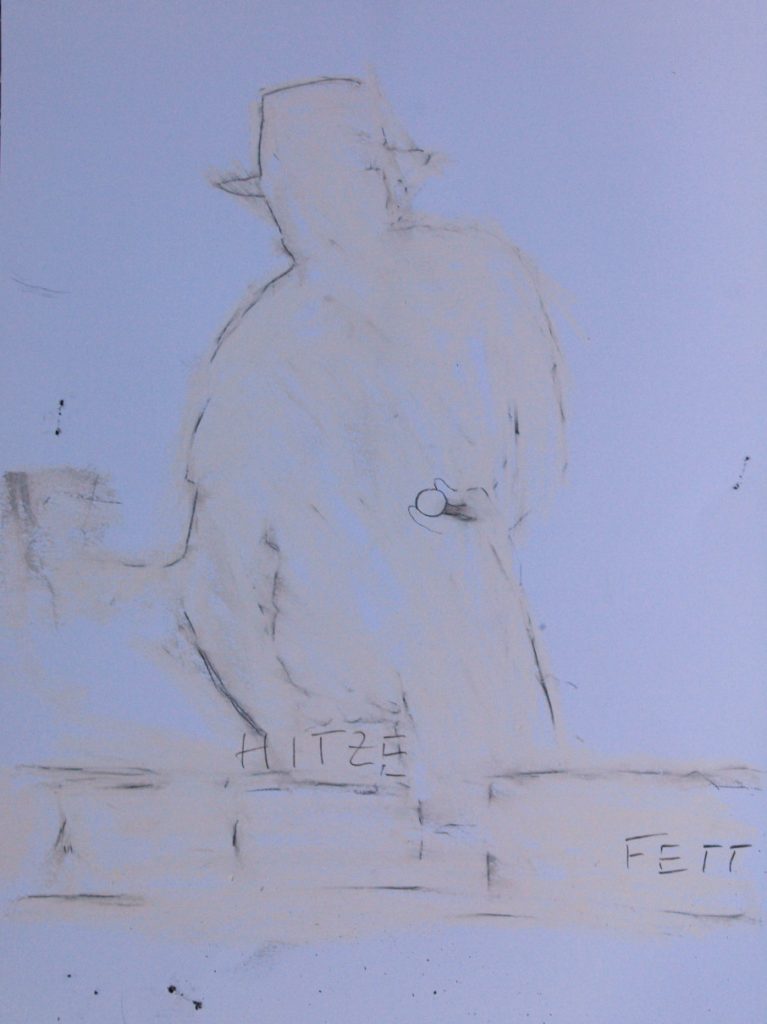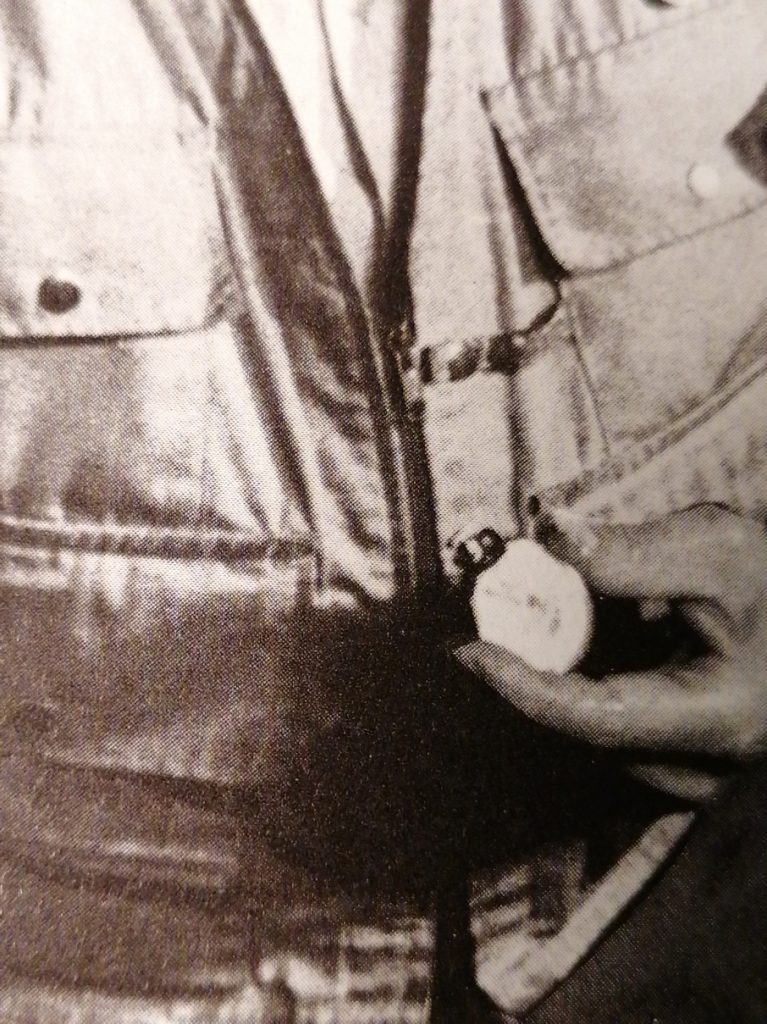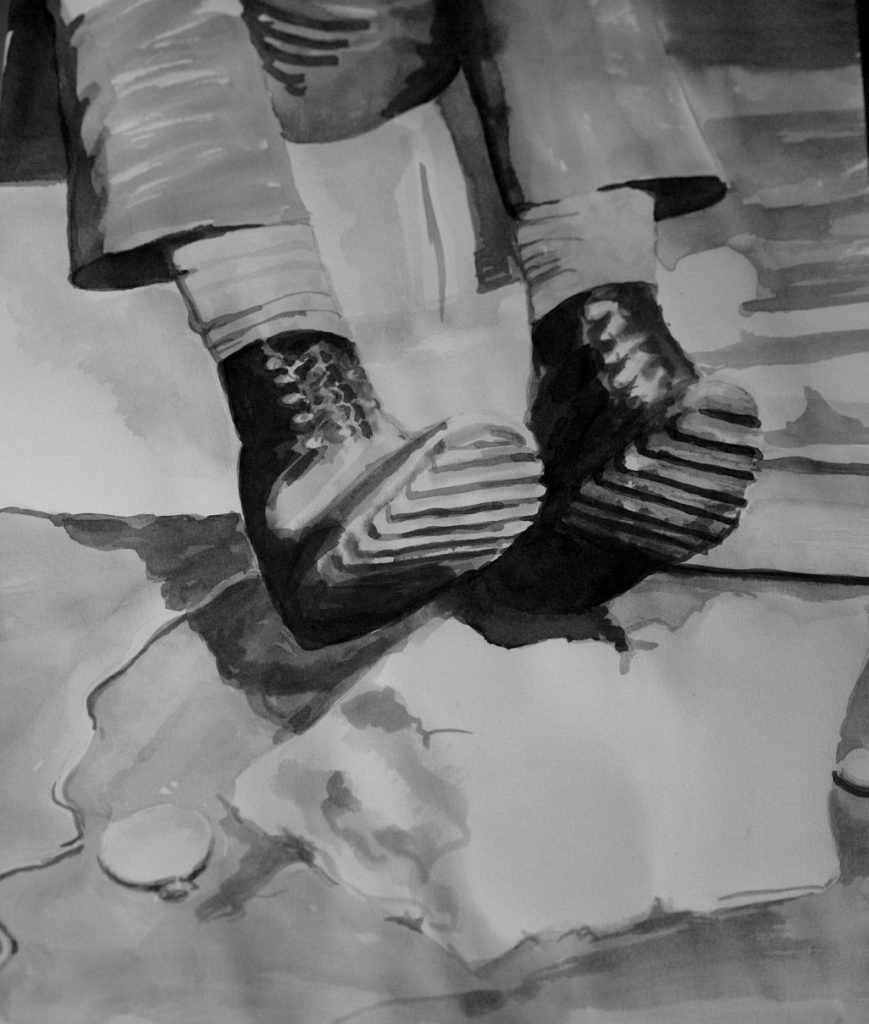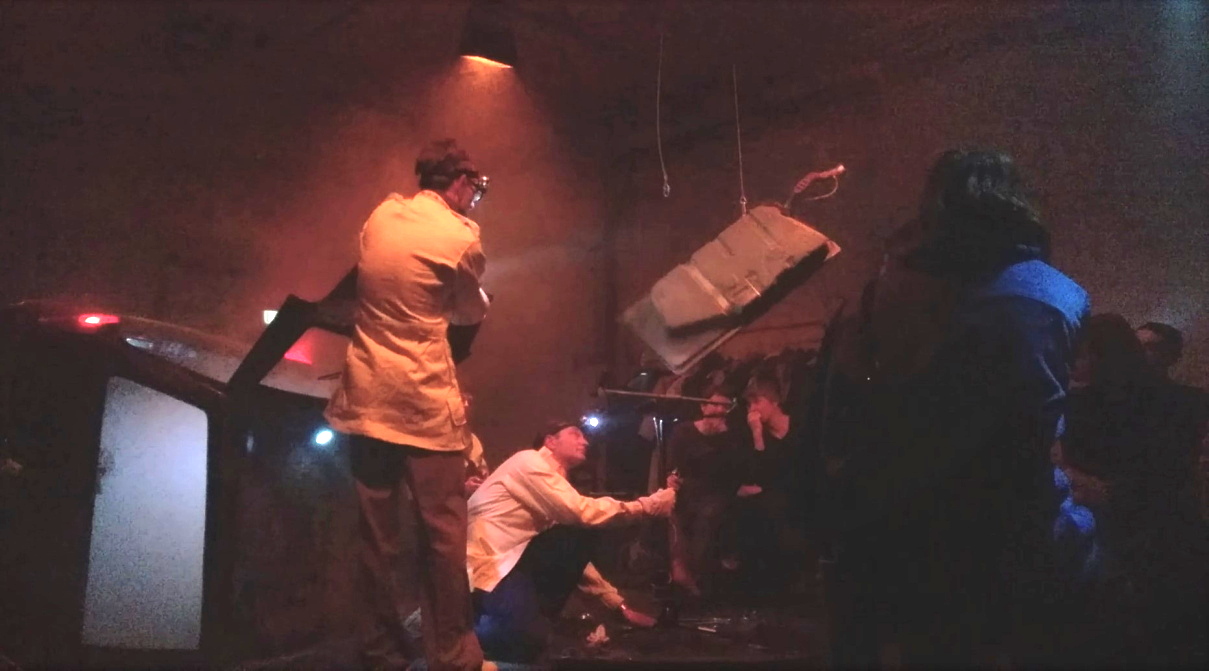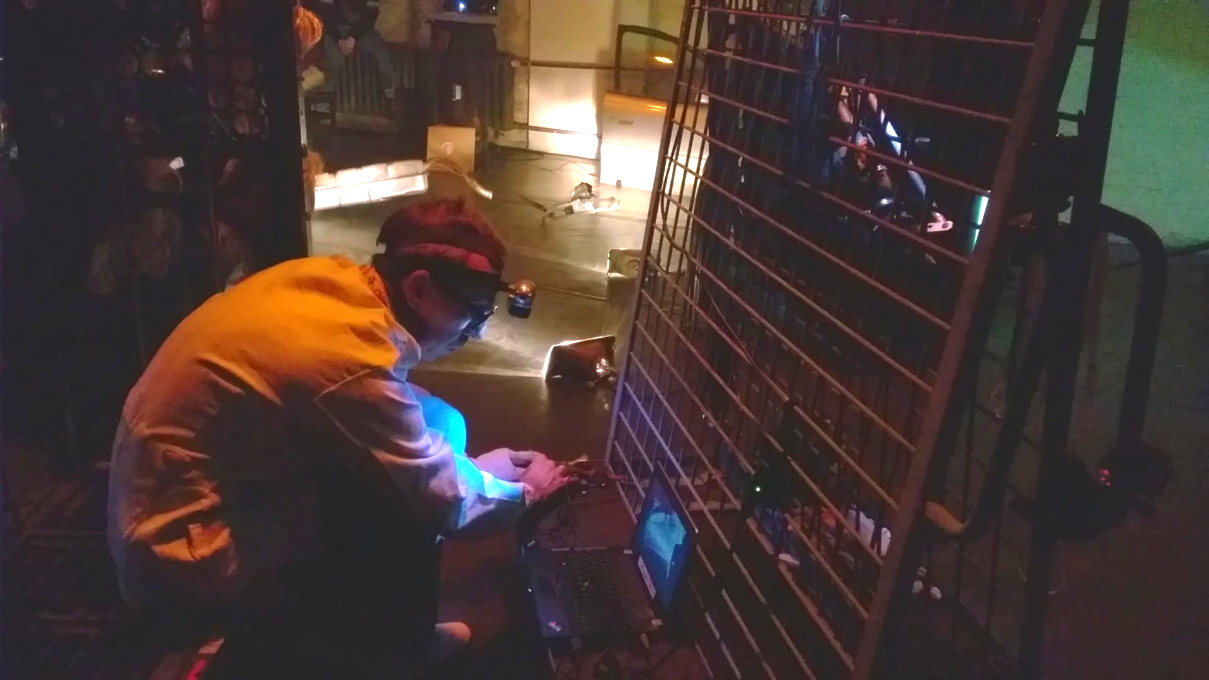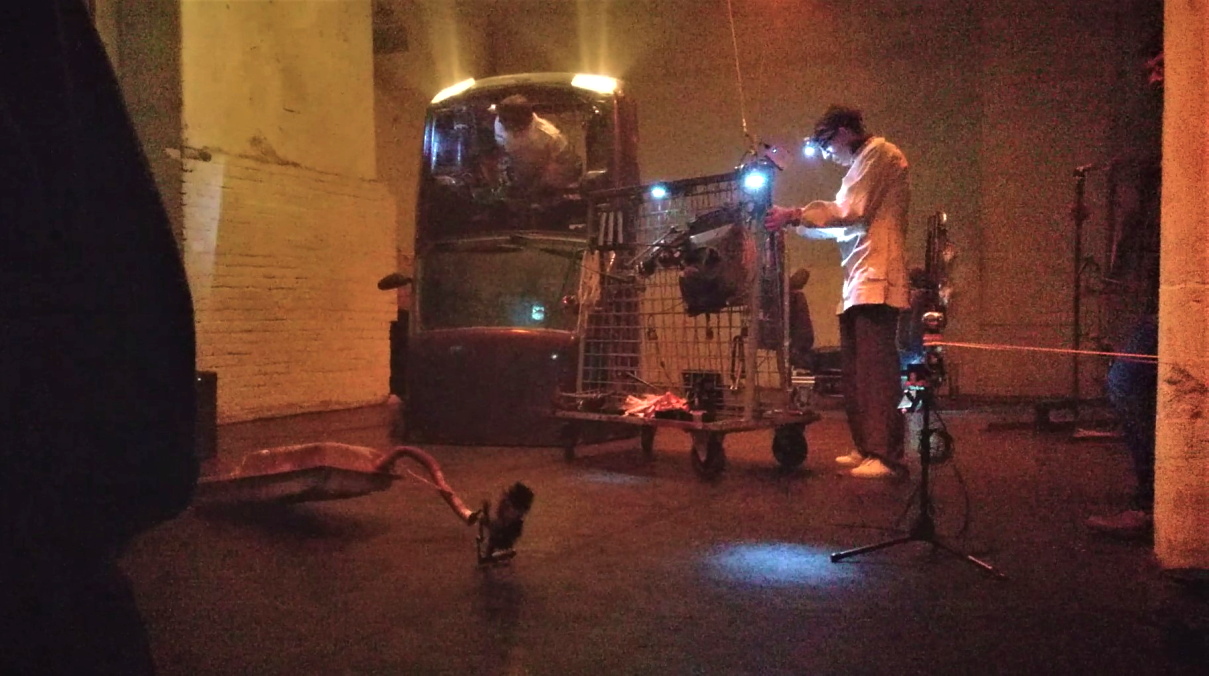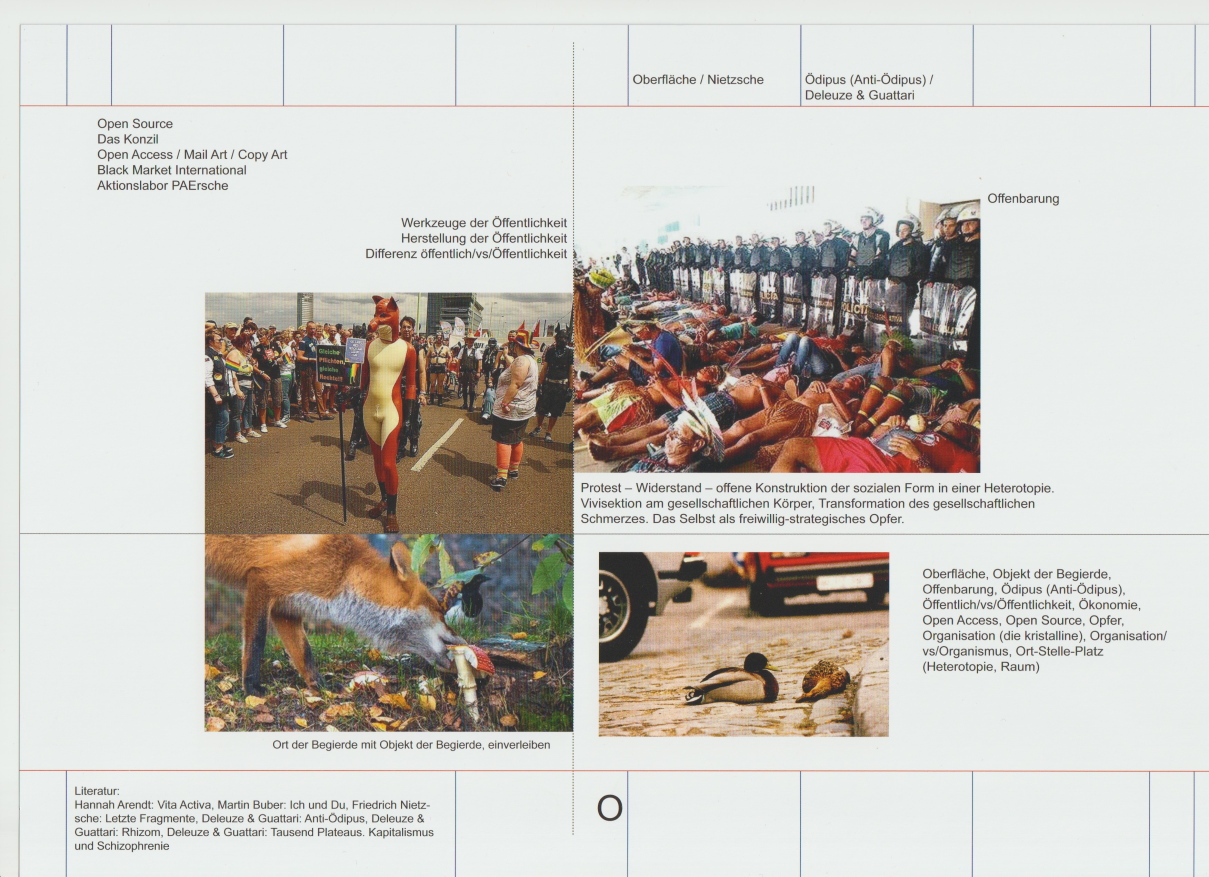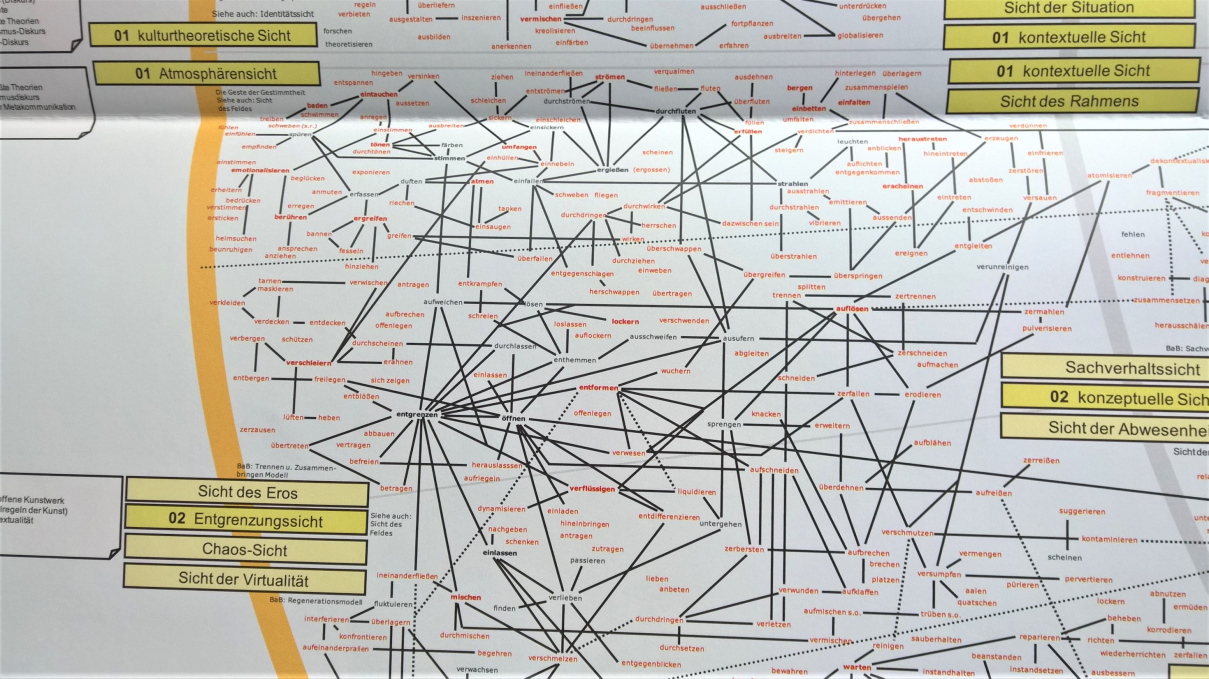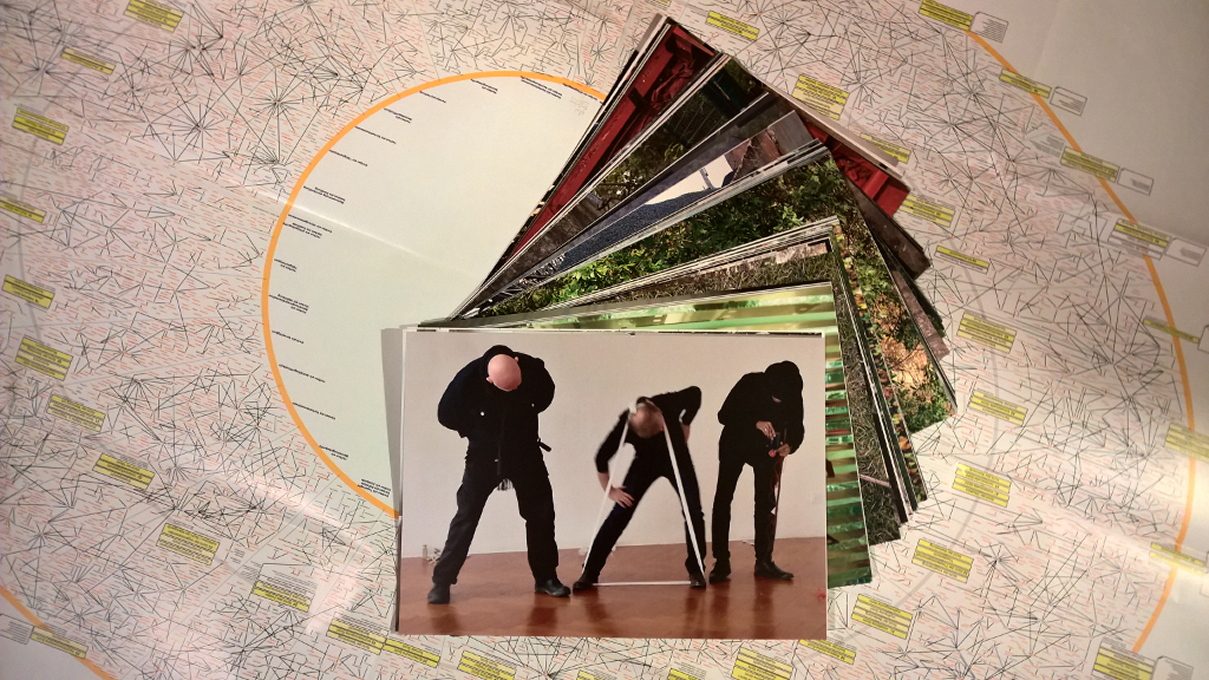Zwischen 1964 und 1987 hat Joseph Beuys bei mehreren Aktionen Wecker und Stoppuhren benutzt. Sie stehen oder liegen meist herum und wurden selten benutzt, weshalb sie leicht zu übersehen sind. Hier wird erörtert, warum sie ein wichtiges Verbindungsstück des Künstlers mit FLUXUS darstellen und überhaupt ein Indikator für die Hinwendung Beuys‘ zu den Zeitkünsten sind.
Ein Wecker mit zwei Glocken stand am Fuß einer fast körperhohen Lautsprecherbox hinter der Beuys während der Aktion : >>Hauptstrom>> und Fettraum am 20. März 1967 in Darmstadt hockend in einer meditativen Haltung verharrte, als würde er dort Deckung suchen
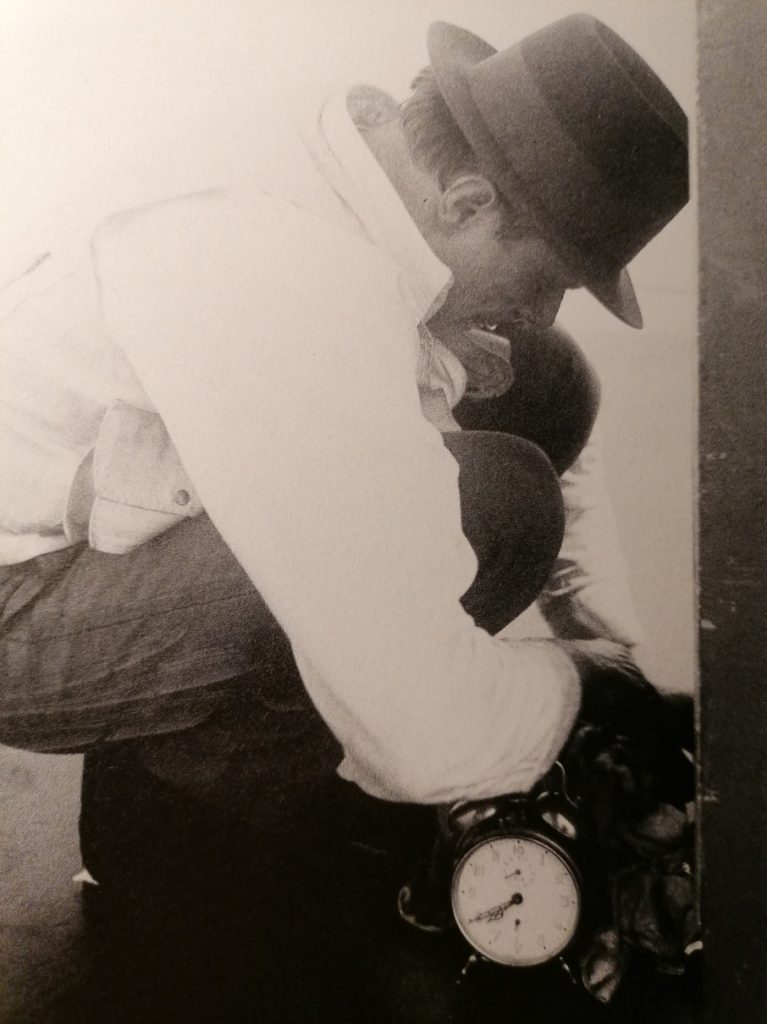
Ein anderer großer Wecker mit Metallgehäuse stand auf einem Konzertflügel, den Beuys spielte. Zu Ehren des Organisators von Fluxus gab er 1987 mit Nam June Paik, der an einem zweiten gegenüber aufgestelltem Flügel saß, das Konzert In memoriam George Maciunas.
Die Uhren in diesen Performances sind kaum beachtet und nur zögerlich in Deutungen eingeflossen. Uwe M. Schneede hat die Stoppuhr bei der Aktion EURASIA Sibirische Symphonie 1963, die Beuys 1966 in der Galleri 101 in Kopenhagen aufgeführt hatte, bemerkt und deutete die Zeitlichkeit im Hinblick auf die beiden Halbkreuze historisch. Schneede bezog sich auf Beuys Wunsch, das Schisma, also die Spaltung des Christentums in eine ost- und eine weströmische Kirche zu überwinden, um auch die unterschiedlichen Wesensarten der Menschen zusammenzubringen. Entsprechend vermutete der Kunsthistoriker in den Stoppuhren angelehnt auch an den Titel eine Anspielung auf die Geopolitik des Doppelkontinents, die er vorsichtshalber mit einem Fragezeichen versehen hat.[i] Dieser Interpretationsvorschlag scheint besonders hinsichtlich der Verwendung von Uhren auch in anderen Aktionen von Beuys, in Bezug auf Dadaismus und Neo-Dadaismus wenig stichhaltig. Eine mögliche Bewandtnis von Uhren mag zunächst einmal innerhalb einer zeitlichen Orientierung liegen, die Beuys als bildender Künstler mit seinen Aktionen suchte. Man muss sich vor Augen führen, dass diese anfänglich ein Experiment waren, mit denen Beuys nach dem Krieg, inspiriert von Fluxus und Happenings als mittlerweile 43-Jähriger seinen Platz in der damaligen Gegenwartskunst suchte. Diese hatte sich während des Krieges und danach vor allen Dingen im Ausland weiterentwickelt, während deutsche Künstler ihren Platz erst wieder finden mussten. Die Faszination, die von Stoppuhren ausging, lässt sich durch die Strahlkraft von neuen Gegenständen erklären, die heute von elektronischen Geräten ausgeht. Stoppuhren wurden zwar schon im 19. Jahrhundert entwickelt, jedoch erst bei der Winterolympiade 1936 erstmalig offiziell eingesetzt. Beuys war damals 15 Jahre, also in einem Alter, in dem junge Leute von Innovationen und Fortschritt begeistert sind.
Uhren im Dadaismus
Als die Stoppuhren olympisch zum Einsatz kamen, hatten die dadaistischen Künstler, sofern sie konnten, Deutschland längst verlassen. Im Exil begeisterte die Rezeption von DADA eine kommende Künstlergeneration, die unmittelbar nach dem Zweiten Weltkrieg die verödete Bühne der Kunst auch in Europa betrat. Deshalb ist es nicht unerheblich, dass Hans Richter in einer Publikation, die 1965 im amerikanischen Exil veröffentlicht wurde, beispielhaft Gegenstände aus seinen Filmen aufzählte. Neben Beinen, Leitern und Hüten erwähnt er auch Uhren. Offensichtlich bezieht er sich auf seinem Film Vormittagsspuk von 1928, in dem „überwiegend natürliche Elemente, die durch ihre stark rhythmischen Bewegungen auffallen“, auf unübliche Weise eingesetzt werden. Dennoch bemerkt er, dass die Uhr „am Anfang (des Films) 11:50 und am Ende 12h mittags angezeigt hätte“, was durchaus ihrer faktischen Funktion als Zeitmesser entsprach. Wie Richter weiter ausführte, gaben sie dem Film, „der voller verrückter Ereignisse war, die dennoch eine Art Geschichte ergeben“[ii], eine real überprüfbare Dauer.
Nun scheint es so zu sein, dass sich die Gegenstände, von denen sich Richter angezogen fühlte, auch im zweiten Dadaismus, dem Neo-Dada, von dem sich auch Beuys nicht allein durch George Maciunas inspirieren ließ, anhaltender Beliebtheit erfreuten. Das lässt sich beim Blättern jedes Katalogs mit Abbildungen von Werken der Fluxuskünstler überprüfen. Es sollte keine Mühe machen, darin Uhren, Füße (Schuhe), Leitern und Hüte zu finden.[iii] Besonders Hüte und Uhren kann man leicht als Fetische und Statussymbole identifizieren, weshalb Richters Hut-Meute, die er im Garten über den Rasen fliegen lässt, Hüte als Symbole patriarchaler Autoritäten parodistisch infrage stellt. Anders verhält es sich mit den Leitern, die als Hilfsmittel beim Aufbau von Ausstellungen unentbehrlich sind und von Fluxuskünstlern gerne als Requisiten in Aktionen verwendet wurden. Als Symbole manifestieren sie den Vorstoß in die Höhe. Als profane Himmelsleitern relativieren sie die transzendentale Ebene und weisen trotzdem auf das durch die Profanierung der Kunst eingetretene Defizit hin. Bekannt ist, dass Hugo Ball sich „Magischer Bischof“ nannte und sich Beuys als Schamane gab. Um das Erreichen einer immaterielle Ebene zu unterstreichen, trugen Ball bei seiner berühmt gewordenen Aktion im Cabaret Voltaire einen hohen Zaubererhut und Beuys nicht nur während seiner Performances einen Stetson.
Stoppuhr als Gadget
In den 1960er Jahren machten Stoppuhren Furore. Sie sind ein must have, wie wir heute sagen würden. Daher wurden sie auch als Kinderspielzeuge produziert, was die Begehrlichkeit populärer Gegenstände unterstreicht, denen sich auch Künstler nicht entziehen konnten. Insofern standen die Stoppuhren, die Beuys in mehreren Performances einsetzte, schon in einer gewissen, wenn auch kurzen Tradition. Dennoch erfordert es eine hohe Aufmerksamkeit, unerwartete Gegenstände auf den unter schlechten Lichtverhältnissen aufgenommenen Fotos zu identifizieren. Während seiner ersten öffentlichen Performance am 20. Juli 1964 im Hörsaal der RWTH in Aachen hielt Beuys eine Stoppuhr in seiner linken Hand, während er mit der rechten die Temperatur der Elektrokochplatte sondierte. Die Stoppuhr gibt der Szene eingangs der beabsichtigten Fettschmelze den Anstrich wissenschaftlicher Präzision. Der erste Teil des Titels der Aktion Kukei, akopee-Nein, Braunkreuz, Fettecken, Modellfettecken verweist dagegen auf Kindersprache. Konkret ist ein Ausspruch von Beuys Sohn überliefert, der nicht zum Eierkaufen mitgehen wollte und solches sagte. Ei heißt in der Rheinischen Kindersprache Kukei und akopee bedeutet einkaufen.
Abb.2 und 3 Zeichnung des Autors nach einem Foto der Aktion Kukei, akopee-Nein, Braunkreuz, Fettecken, Modellfettecken, Foto von … (Mich hat dieser Titel jedenfalls dazu verführt, anfangs statt der Stoppuhr ein Ei in der Hand von Beuys zu erkennen und es so abzuzeichnen.) Abb. 3 Ausschnitt aus der Abbildung des Fotos von Peter Thomann, in: Schneede: Joseph Beuys: Die Aktionen, Stuttgart 1994
Möglicherweise benutzte Beuys dieselbe Stoppuhr ein Jahr später, am 5. Juni 1965, bei der Performance und in uns … unter uns … Land unter … in der Gal. Parnass in Wuppertal. Auf einigen Fotos von Heinrich Riebesehl und Ute Klophaus erkennt man jedenfalls eine Stoppuhr zwischen einem Stromkabel und dem Haufen Fett, auf dem Beuys Füße stehen, die in einem Paar Schuhe mit einem markanten quer gerillten Profil stecken.
Was Stoppuhren besonders macht
Die Verwendung der Stoppuhr wäre trivial, wenn sie zuvor nicht wesentliche Parameter in der Arbeitswelt und im Sport grundlegend verändert hätte. Die Stoppuhr ist nämlich im Gegensatz zur Sonnen-, Stand-, Taschen- und Armbanduhr kein Instrument der zyklischen Zeitmessung. Die Stoppuhr misst die Dauer eines Ereignisses linear. Sie macht die Zeit für eine bestimmte Strecke oder eine bestimmte Arbeit vergleichbar. Als ein Instrument, das bei der Messung von Arbeitsintervallen eine entscheidende Rolle gespielt hat, wurde sie zu einer Voraussetzung der wissenschaftlichen Erforschung der Arbeit, die es erlaubte, Arbeitsschritte am Fließband zu zerlegen und zu optimieren, was die moderne Massenproduktion in Gang setzte.[iv]
Erst 50 Jahren später wurden Stoppuhren als offizielle Zeitmessgeräte z.B. bei Olympischen Spielen eingesetzt. Die ersten bei einer Olympiade gestoppte Zeit nahmen die Juroren bei einem Skirennen 1936.
Frappierend Auswirkungen im Sport
Entschied bis ins 19. Jahrhundert bei Wettbewerben derjenige der als Erster die Ziellinie überschritt, ein Rennen für sich, so laufen die Wettbewerber heute nicht mehr nur um den Sieg gegeneinander. Seit Rekordzeiten für die zurückgelegten Distanzen festgehalten werden, kämpfen alle Athleten auch gegen die Uhr. Sie haben nicht nur die Chance zu gewinnen, sondern auch der oder die Schnellste „aller Zeiten“ zu werden. Dieser Superlativ setzt stillschweigend voraus, dass die Läufer vor der Erfindung der Uhr langsamer waren. Dafür spricht, dass die Läufer vor der Erfindung der Zeitmessung nur schneller, weiter und höher als ihre Mitbewerber zu sein hatten. Heute müssen sie gegen alle bisher aufgezeichneten Bestmarken in einer Disziplin anlaufen, anspringen und anwerfen und dazu die letzten Reserven mobilisieren. Ganze Geschäftszweige sind entstanden, um die sport- und ernährungswissenschaftlichen Erkenntnisse umsetzen und um Techniken zu trainieren, damit auch neuerlich antretende Leistungssportler*innen gegen die von Generation zu Generation höher geschraubten Rekorde bzw. kürzeren Zeiten bestehen können. Die Zeitmessung hat nicht nur die Ergebnisse objektiviert, sondern treibt Sportler in einen Phantom-Wettbewerb gegen die Athleten aus der Vergangenheit.
Welches Verhältnis zur Zeit prägte Beuys
Vor diesem Hintergrund stellt sich nun die Frage, welche Erfahrungen sich in der Benutzung von Uhren durch Beuys niederschlugen. Dagegen, dass Uhren lediglich als ein Statussymbol verwendet worden sind, spricht die Anlehnung des Künstlers an Fluxus während der betreffenden Zeit. Der Kontext seiner ersten Aktion auf dem Festival für Neue Kunst an der Rheinisch-Westfälischen Technischen Hochschule (RWTH) in Aachen, die am 20. Juli 1964, also am 20. Jahrestag des Anschlags auf Hitler durch Stauffenberg, stattfand, spricht dafür, dass der Krieg bei seiner Aktion nicht unerheblich mitschwang, zumal an diesem Ort die wissenschaftlichen und ingenieurmäßigen Voraussetzungen auch für die Produktion von Waffen geschaffen wurden.
Zeit totschlagen
Beuys hatte sich bekanntlich freiwillig zur Luftwaffe gemeldet und war Berufssoldat geworden, womit er sich als 19-Jähriger der soldatischen Disziplin und einem strengen Zeitregime unterwerfen musste. Nicht zuletzt weil sein Traum, Pilot zu werden, platzte, musste er als Gefreiter und späterer Unteroffizier unter dem Wechsel aus Drill und Nichtstun gelitten haben; hatte er doch nach der Ausbildung vier Jahre lang den grotesken Kontrast zwischen lebensgefährlichen Einsätzen und einer öden Routine des Kasernenalltags auszuhalten. Nach den Einsätzen auf der Krim mit der Bombardierung von Sebastopol wurden Stukas nur noch selten benötigt, denn sie waren schnelleren alliierten Abfangjägern unterlegen. Zudem konnten sie wegen ihrer geringen Nutzlast nur noch selten als Bomber abheben. Die Besatzungen mussten Zeit totschlagen und ihre jungen Jahre verstrichen. Auch im Ausland, wie auf einer Luftwaffenbasis in Foggia wurden nur wenige Übungen und ein paar Einsätze jenseits der Adria geflogen. Ansonsten war den Soldaten der Umgang mit Einheimischen verboten.
ZEIT AUF NULL STELLEN
Gegenüber dem Verrinnen der Zeit, für das die Sanduhr seit jeher ein Symbol ist, das mit dem des Todes verbunden ist, verkörpert die Stoppuhr, die sich auf Null zurückstellen lässt, die Chance des Neuanfangs. Stoppuhren lassen sich zur Ermittlung von Zwischenzeiten sogar anhalten und laufen mit einem zweiten Klick weiter, weshalb sie die Möglichkeit bieten, Zeit in messbare Intervalle zu zerlegen. Die Utopie der Nullstellung von Zeit sah Walter Benjamin durch französische Revolutionäre eingefordert, die in der Julirevolution von 1830 am Ende von Straßenkämpfen unabhängig voneinander auf Uhren geschossen haben sollen. Schon die Revolution von 1789 hatte als Basis eines revolutionären Neuanfangs die Einführung eines neuen Kalenders gebracht, dem statt der traditionellen Aufteilung in 12 Monate, 52 Wochen und 24 Stundentage, das Dezimalsystem mit 10 Monaten zugrunde gelegt wurde. Bemerkenswerterweise schlagt in der Stoppuhr die traditionelle Unterteilung der Zeit nach dem Duodezimalsystem, das die Stunden in 60 Minuten und Minuten in 60 Sekunden teilt, nach dem Komma in das Dezimalsystem um, so dass die Sekunden in Zehntel, Hundertstel und Tausendstel unterteilt werden. Hier koexistiert ein Rest des Dezimalsystems, das nach der Französischen Revolution die Zehntagewoche gebracht hatte, mit der traditionellen Zeitmessung, die wieder eingesetzt worden ist, weil Wochen mit 10 Tagen unzumutbar waren.
Die Funktion der Stoppuhr, die beliebig viele Neuanfänge suggeriert, kam Beuys entgegen, der nach dem Krieg mit dem Kunststudium einen Neuanfang gewagt hatte, aber durch eine Depression wieder zurückgeworfen wurde. Nach seiner Zeit auf dem Hof der Familie van der Grinten fand er als Lehrbeauftragter an die Kunstakademie zurück, wo es zur Begegnung mit Fluxuskünstlern kam. Ihre unakademische Auffassung der Kunst vermittelten Beuys einen Impuls, der sein Verhältnis zur Kunst veränderte. Mit seiner ersten Aktion 1964, die er als 43-Jähriger durchführte, begann er einen künstlerischen Weg bei NULL.[v]
[i] (Schneede, 1994) Schneede bezieht sich auf die Utopie von Rudolf Steiner und schreibt: „In diesem Sinne stellte Beuys eine Vereinigung der angenommenen östlichen Intuition und der angenommenen westlichen Vernunft als Basis gegenseitiger Befruchtung und politischer Befriedung vor. Die beiden kleinen Kreuze dürften auf die frühe Trennung der Religionen (Rom – Byzanz) und damit auf die Notwendigkeit, diese Trennung zu überwinden, hinweisen. An die Stelle des zuvor bei Beuys eingesetzten Erlösungssymbols der Sonne erhielten die Kruzifixe hier aufgezogen Uhren – Hinweise auf die zeitliche Begrenztheit und damit Historizität der politischen und der geistigen Teilung?“ (S. 129) Schneede versieht seine Vermutung mit Recht mit einem Fragezeichen, denn eine vermeintliche Sonne ist unter den Stoppuhren nicht auszumachen. Die Feststellung, dass die Uhren aufgezogen seien, ist irrelevant, weil das nur eine Rolle spielt, wenn sie konkret zur Zeitmessung eingesetzt werden.
[ii] In: Richter, “My Experience with Movement in Painting and in Film,” in: The Nature and Art of Motion, ed. by Gyorgy Kepes (New York: George Braziller, 1965), 155. Zit nach: Richter’s Films and the role of the radical artists, by Marion von Hofacker, In: ACTIVISM_MODERNISM_AND_THE_AVANT-GARDE ed. By Daniel Valdes Puertos, (Anm 17), S. 134
[iii] Als Beispiele seien hier nur das Archiv Sohm in der Staatsgalerie Stuttgart (Kellein, 1986) und der Katalog der Sammlung Silverman (Hendricks, 1983) genannt.
[iv] Frederick Winslow Taylor hatte seit 1880 die Stoppuhr eingesetzt, um Arbeitsschritte zu zergliedern und zu optimieren (Giedion, 1982), S. 122, 140
[v] Einen voraussetzungslosen Neuanfang hatte auch die Gruppe ZERO unter anderen ästhetischen Vorzeichen zu ihrem Namen gebracht, denn sie experimentierten mit Licht und Abstraktion. Mit dem Titel Le Degré zéro de l’écriture (Paris 1953) hatte Roland Barthes der französischen Literatur einen Neuanfang bescheinigt.

